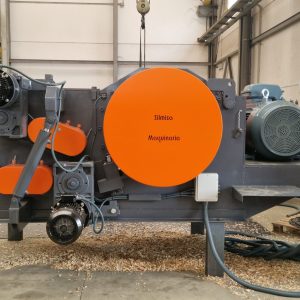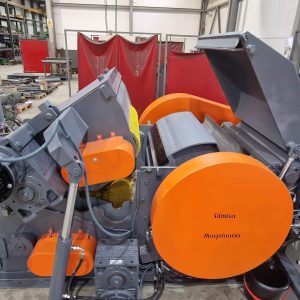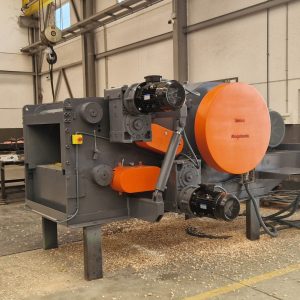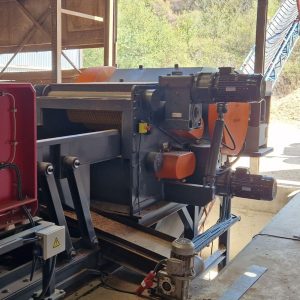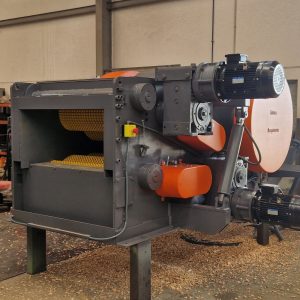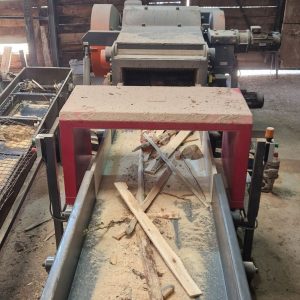Efficient wood waste management is one of the fundamental pillars of companies committed to sustainability and the circular economy. In this context, the wood chipper is presented as an effective industrial solution for transforming wood waste into useful raw material, boosting both biomass production and recycling in sectors such as forestry, agriculture, urban planning, and industry.
At Silmisa Maquinaria, we design and manufacture specialized equipment for material processing, including our wood chippers, designed to offer maximum robustness, continuous performance, and adaptability to multiple production environments. Throughout this article, we’ll delve into the most relevant aspects of our Titan wood chipper, from its applications to the advantages of choosing state-of-the-art equipment, as well as technical and maintenance considerations.
What is a wood chipper and what is it used for?
Definition and main applications
A wood chipper is a machine designed to process logs, branches, and wood waste into chips of uniform size. The process involves feeding the material through an inlet, where a cutting system breaks the wood into manageable pieces ready for later use.
These machines are essential in different sectors such as:
- Biomass and renewable energy: Wood chips are an excellent fuel for boilers and biomass plants.
- Panel manufacturing: Uniformly sized chips are ideal for particle board production.
- Composting and gardening: The finest chips are used as raw material in composting and garden decoration.
- Paper and pulp industry: Wood chips are used as raw material in the manufacture of paper and pulp.
Essential components for high performance
A quality chipper must have a set of components that guarantee efficiency, safety, and durability. Key components include:
- High inertia cutting rotor or drum.
- Hydraulic or mechanical power supply system.
- Interchangeable hardened steel blades.
- Large, easily accessible loading hopper.
- Evacuation system using belt or pneumatic ejector.
Each component must be designed to withstand demanding conditions, with accessible maintenance and built-in safety mechanisms.
Manufacturing materials and machine lifespan
The choice of structural materials determines the durability of the equipment. At Silmisa Maquinaria, we manufacture our chippers with high-strength steel, oversize shafts, and anti-abrasion guards to guarantee:
- Long service life in intensive environments.
- Reduction in maintenance downtime.
- High resistance to impacts and wear.
In addition, the use of easily replaceable, low-cost wear elements improves long-term profitability.
Advantages of using chippers in professional environments
Increased operational efficiency
The wood chipper optimizes the time and resources dedicated to waste processing by transforming large volumes of material into an easily storable and transportable product. This translates into increased productivity and a significant reduction in work time.
Reduction of costs and storage space
By converting waste into chips, the volume is reduced by up to 80%, resulting in considerable savings in storage and transportation costs. Furthermore, the chips can be marketed, generating additional revenue for the company.
Contribution to sustainability and the circular economy
Using a wood chipper promotes resource reuse and waste reduction, actively contributing to environmental sustainability and the development of the circular economy. Companies that incorporate these solutions improve their image and comply with the most stringent environmental regulations.
Technology and innovation in Silmisa’s chippers
Models adapted to each need
At Silmisa Maquinaria, we have industrial chippers capable of adapting to different production levels and types of wood materials. Our models are distinguished by:
- Processing capacity.
- Feeding and discharge type.
- Level of automation and electrical controls.
- Ease of integration into demanding processes.
We work individually with each client to configure the most appropriate solution for their facility, taking into account factors such as the type of waste, available space, and frequency of use.
Integration into wood treatment lines
Our chippers can operate independently or be integrated into more complex processing systems. They are compatible with:
- Pre- or secondary crushers.
- Classifying screens.
- Industrial conveyors.
- Suction and filtration systems.
It allows you to configure complete wood recycling lines adapted to large-scale or modular projects.
In addition, we incorporate remote control systems, PLC monitoring, and automatic stop sensors to increase operational safety.
Facilities from our wood chippers
